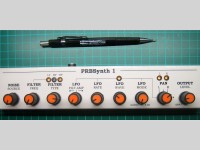Synthesizer PRBSynth1

Music synthesizer based on noise and pattern generation. Sound effects, percussion and pitched sounds can be generated. Comes with multimode filter, LFO and stereo panning modulator. Sound examples included.
PRBSynth1 concept: A monophonic music synthesizer using a noise and random pattern generator instead of an oscillator (no samples). 8 potmeters control all sound parameters using voltages (no menus). Patterns can also be played and triggered as musical scale notes via MIDI. The potmeter values are coupled to MIDI controllers.
Basic synth structure: (see document "synth basic diagram")
The generator output passes a filter (LP/BP/HP/BR with variable Q), amplitude control and a stereo panning circuit. An LFO modulates parameters and can create beats.
The housing is made from a piece of cable tray. The frontpanel is a transparant sticker printed on a inkjet printer. Sidepanel opens up to have acces to the (re-)programming connector. The unit runs on an internal rechargeable battery or external 9V adapter.
Audio generation and processing is almost completely software based.
The name PRBSynth comes from: Pseudo Random Bit Sequence because several of those sequences are generated to make noise colors, continuous changing soundpatterns and modulations.The generator and software filter run at 40kHz sampling rate in combination with lower speed LFO modulation, potmeter readout and MIDI control. Audio is send out via a (rather special, binairy-trinairy) resistor based DAC. A small Arduino Promini 8 bit board with 2k RAM does all of this. On the hardware side all of its I/O pins are used.
Status :
Although (software-based) projects like this are never really finished, the PCB is working fine, I assembled two of them, the code works and I could use the unit in a electronic music environment, check "demo songs" on my website. I consider it a working product that might be interesting for others.
Building it: (see circuit diagrams, comp.zip and PCB info files)
The panning circuit is the only analog audio "circuit" (no chips, just 2 diodes).
This means the hardware is kept rather simple, see circuit: prbsynth1a-circ.
A more simplified PCBversion is possible by skipping the panning function, see circuit: prbsynth1b-circ. That one could even be build on a breadboard instead of using a PCB.You could run the code, a mix of C and Arduino commands, on other ATmega328 boards like the Uno but this one would restrict you to 6 potmeters max.
An example of a this simplified breadboard version using the Arduino-UNO is also given (picture+schematic+code).
For the PCB version check the ProMini pin-positions with the picture (some ProMini versions have other physical positions of pins) The one mentioned in the "comp.zip" file fits the PCB.
My skills are more on analog hardware, so I am sure that the code has ugly parts but it works and is fast enough. The basic concepts of the software and the software filter in specific are shown in the attached documents.
More background information on the circuits, example sounds and "demo-songs" can be found on my personal website: www.rs-elc.nl
Basic synth structure: (see document "synth basic diagram")
The generator output passes a filter (LP/BP/HP/BR with variable Q), amplitude control and a stereo panning circuit. An LFO modulates parameters and can create beats.
The housing is made from a piece of cable tray. The frontpanel is a transparant sticker printed on a inkjet printer. Sidepanel opens up to have acces to the (re-)programming connector. The unit runs on an internal rechargeable battery or external 9V adapter.
Audio generation and processing is almost completely software based.
The name PRBSynth comes from: Pseudo Random Bit Sequence because several of those sequences are generated to make noise colors, continuous changing soundpatterns and modulations.The generator and software filter run at 40kHz sampling rate in combination with lower speed LFO modulation, potmeter readout and MIDI control. Audio is send out via a (rather special, binairy-trinairy) resistor based DAC. A small Arduino Promini 8 bit board with 2k RAM does all of this. On the hardware side all of its I/O pins are used.
Status :
Although (software-based) projects like this are never really finished, the PCB is working fine, I assembled two of them, the code works and I could use the unit in a electronic music environment, check "demo songs" on my website. I consider it a working product that might be interesting for others.
Building it: (see circuit diagrams, comp.zip and PCB info files)
The panning circuit is the only analog audio "circuit" (no chips, just 2 diodes).
This means the hardware is kept rather simple, see circuit: prbsynth1a-circ.
A more simplified PCBversion is possible by skipping the panning function, see circuit: prbsynth1b-circ. That one could even be build on a breadboard instead of using a PCB.You could run the code, a mix of C and Arduino commands, on other ATmega328 boards like the Uno but this one would restrict you to 6 potmeters max.
An example of a this simplified breadboard version using the Arduino-UNO is also given (picture+schematic+code).
For the PCB version check the ProMini pin-positions with the picture (some ProMini versions have other physical positions of pins) The one mentioned in the "comp.zip" file fits the PCB.
My skills are more on analog hardware, so I am sure that the code has ugly parts but it works and is fast enough. The basic concepts of the software and the software filter in specific are shown in the attached documents.
More background information on the circuits, example sounds and "demo-songs" can be found on my personal website: www.rs-elc.nl



Updates vom Autor